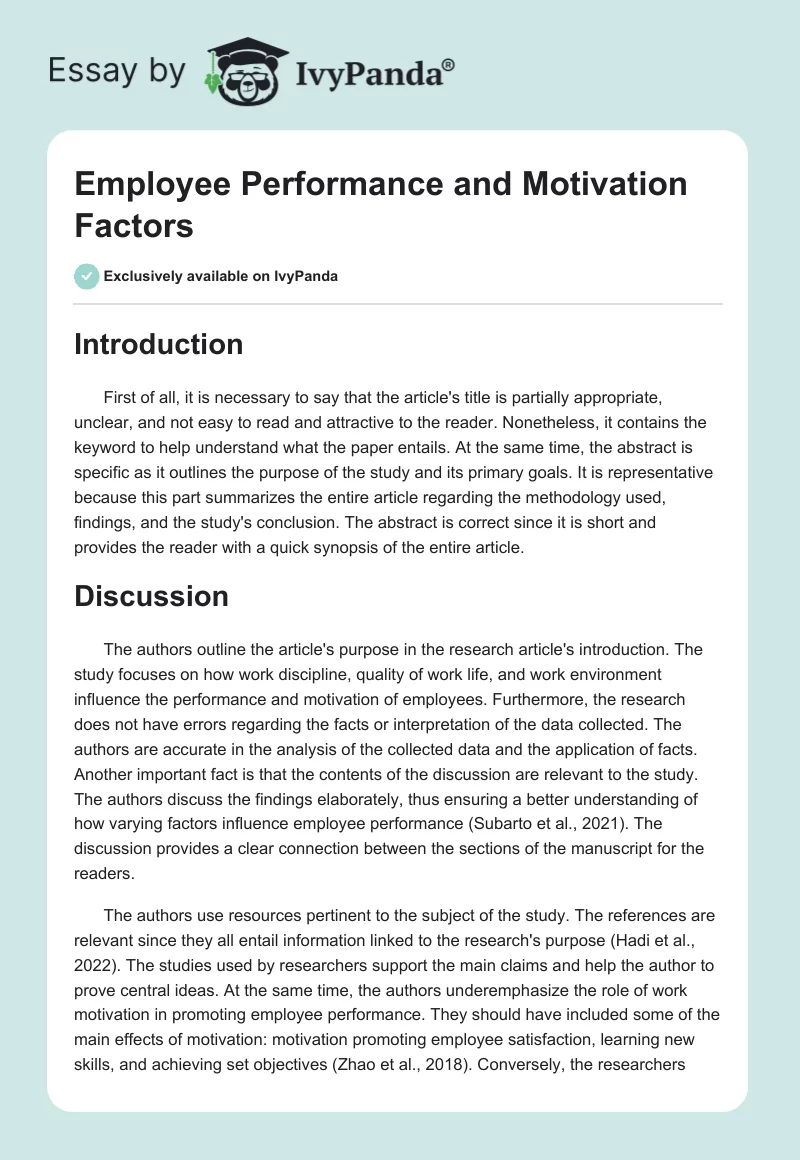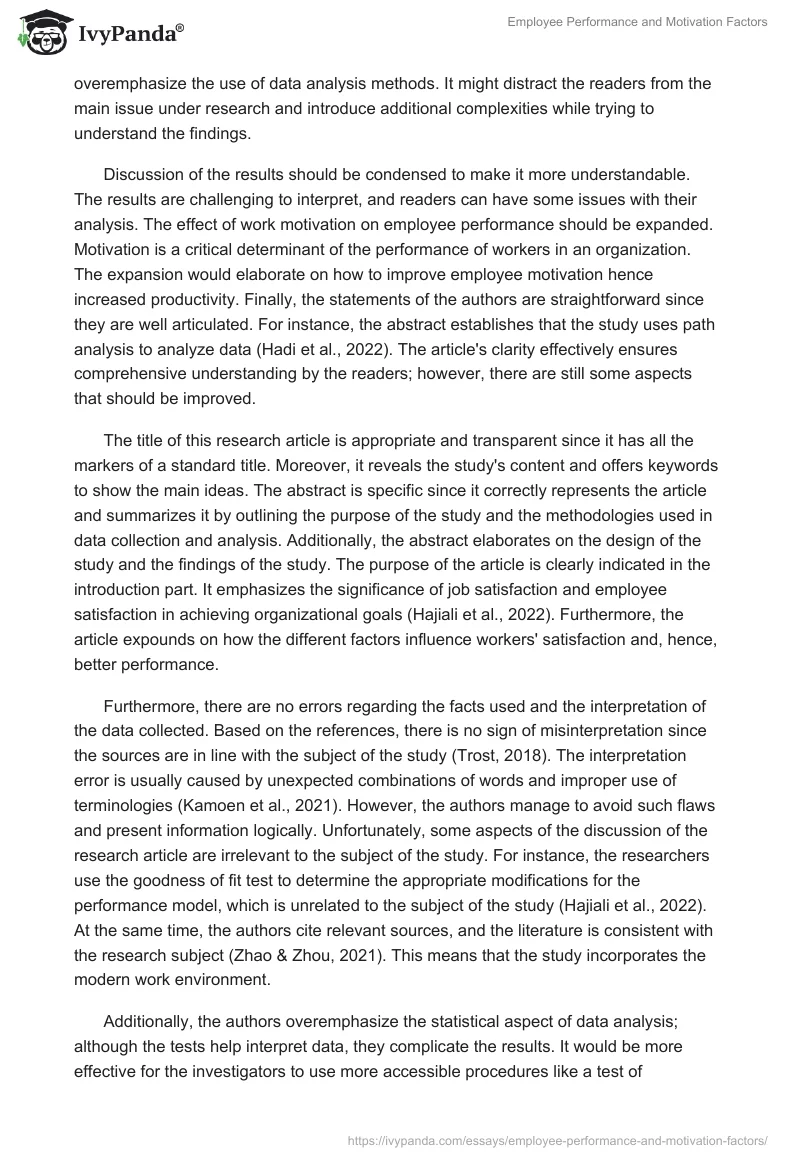Introduction
First of all, it is necessary to say that the article’s title is partially appropriate, unclear, and not easy to read and attractive to the reader. Nonetheless, it contains the keyword to help understand what the paper entails. At the same time, the abstract is specific as it outlines the purpose of the study and its primary goals. It is representative because this part summarizes the entire article regarding the methodology used, findings, and the study’s conclusion. The abstract is correct since it is short and provides the reader with a quick synopsis of the entire article.
Discussion
The authors outline the article’s purpose in the research article’s introduction. The study focuses on how work discipline, quality of work life, and work environment influence the performance and motivation of employees. Furthermore, the research does not have errors regarding the facts or interpretation of the data collected. The authors are accurate in the analysis of the collected data and the application of facts. Another important fact is that the contents of the discussion are relevant to the study. The authors discuss the findings elaborately, thus ensuring a better understanding of how varying factors influence employee performance (Subarto et al., 2021). The discussion provides a clear connection between the sections of the manuscript for the readers.
The authors use resources pertinent to the subject of the study. The references are relevant since they all entail information linked to the research’s purpose (Hadi et al., 2022). The studies used by researchers support the main claims and help the author to prove central ideas. At the same time, the authors underemphasize the role of work motivation in promoting employee performance. They should have included some of the main effects of motivation: motivation promoting employee satisfaction, learning new skills, and achieving set objectives (Zhao et al., 2018). Conversely, the researchers overemphasize the use of data analysis methods. It might distract the readers from the main issue under research and introduce additional complexities while trying to understand the findings.
Discussion of the results should be condensed to make it more understandable. The results are challenging to interpret, and readers can have some issues with their analysis. The effect of work motivation on employee performance should be expanded. Motivation is a critical determinant of the performance of workers in an organization. The expansion would elaborate on how to improve employee motivation hence increased productivity. Finally, the statements of the authors are straightforward since they are well articulated. For instance, the abstract establishes that the study uses path analysis to analyze data (Hadi et al., 2022). The article’s clarity effectively ensures comprehensive understanding by the readers; however, there are still some aspects that should be improved.
The title of this research article is appropriate and transparent since it has all the markers of a standard title. Moreover, it reveals the study’s content and offers keywords to show the main ideas. The abstract is specific since it correctly represents the article and summarizes it by outlining the purpose of the study and the methodologies used in data collection and analysis. Additionally, the abstract elaborates on the design of the study and the findings of the study. The purpose of the article is clearly indicated in the introduction part. It emphasizes the significance of job satisfaction and employee satisfaction in achieving organizational goals (Hajiali et al., 2022). Furthermore, the article expounds on how the different factors influence workers’ satisfaction and, hence, better performance.
Furthermore, there are no errors regarding the facts used and the interpretation of the data collected. Based on the references, there is no sign of misinterpretation since the sources are in line with the subject of the study (Trost, 2018). The interpretation error is usually caused by unexpected combinations of words and improper use of terminologies (Kamoen et al., 2021). However, the authors manage to avoid such flaws and present information logically. Unfortunately, some aspects of the discussion of the research article are irrelevant to the subject of the study. For instance, the researchers use the goodness of fit test to determine the appropriate modifications for the performance model, which is unrelated to the subject of the study (Hajiali et al., 2022). At the same time, the authors cite relevant sources, and the literature is consistent with the research subject (Zhao & Zhou, 2021). This means that the study incorporates the modern work environment.
Additionally, the authors overemphasize the statistical aspect of data analysis; although the tests help interpret data, they complicate the results. It would be more effective for the investigators to use more accessible procedures like a test of hypothesis and regression analysis (Rong & Bao-Wen, 2018). Additionally, the researchers underemphasize the importance of employee motivation. The article focuses on motivation theories; instead, the authors should have exhausted the benefits of the same, which include increased retention, reduced turnover, improved relations, and reduced absenteeism among workers.
Conclusion
The conclusion section should be expanded to accommodate the study’s final findings. In general, the research is comprehensive, but the conclusion is minimal. At the same time, the literature review section should be condensed since it only lays the foundation for the research. The extensive literature review section is irrelevant as more attention is given to data analysis. Section of the goodness of fit test should be omitted since it applies a complex procedure that results in incomprehensible findings (Bentler & Bonett, 2020; Chen & Balakrishnan, 2019). In general, the authors’ statements are not ambiguous since all sections of the manuscript are understandable. For instance, in the research methods section, the authors clearly outline the method used for data collection as the census method (Hajiali et al., 2022). The clarity of the article’s statements is essential in ensuring better comprehension of the study.
References
Bentler, P. M., & Bonett, D. G. (2020). Significance tests and goodness of fit in the analysis of covariance structures. Psychological Bulletin, 88(3), 588. Web.
Chen, G., & Balakrishnan, N. (2019). A general-purpose approximate goodness-of-fit test. Journal of Quality Technology, 27(2), 154-161. Web.
Hadi, M. A., Wibowo, A., Edy Wibowo, A., Jalil, M., & Waskito Adi, T. (2022). The influence of work discipline, quality of work life (QWL) and work environment on work motivation and its impact on the performance of MSME employees in Pasuruan Regency. Enrichment: Journal of Management, 12(4), 2792-2803. Web.
Hajiali, I., Kessi, A. M. F., Budiandriani, B., Prihatin, E., & Sufri, M. M. (2022). Determination of work motivation, leadership style, employee competence on job satisfaction, and employee performance. Golden Ratio of Human Resource Management, 2(1), 57-69. Web.
Kamoen, A., Dermaut, L., & Verbeeck, R. (2021). The clinical significance of error measurement in the interpretation of treatment results. The European Journal of Orthodontics, 23(5), 569-578. Web.
Rong, S., & Bao-Wen, Z. (2018). The research of regression models in the machine learning field. MATEC Web of Conferences ,176, 01033. Web.
Subarto, S., Solihin, D., & Qurbani, D. (2021). Determinants of job satisfaction and its implications for the lecturers performance. Jurnal Pendidikan Ekonomi Dan Bisnis, 9(2), 163-178. Web.
Trost, R. P. (2018). Interpretation of error covariances with nonrandom data: An empirical illustration of returns to a college education. Atlantic Economic Journal, 9(3), 85-90. Web.
Zhao, H., & Zhou, Q. (2021). Socially responsible human resource management and hotel employee organizational citizenship behavior for the environment: A social cognitive perspective. International Journal of Hospitality Management, 95, 102749. Web.
Zhao, X. (Roy), Ghiselli, R., Law, R., & Ma, J. (2018). Motivating frontline employees: Role of job characteristics in work and life satisfaction. Journal of Hospitality and Tourism Management, 27, 27–38. Web.


